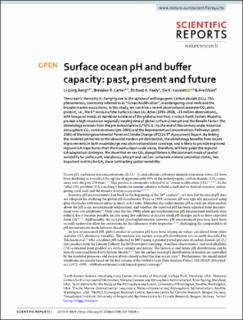| dc.description.abstract | The ocean’s chemistry is changing due to the uptake of anthropogenic carbon dioxide (CO2). This phenomenon, commonly referred to as “Ocean Acidification”, is endangering coral reefs and the broader marine ecosystems. In this study, we combine a recent observational seawater CO2 data product, i.e., the 6th version of the Surface Ocean CO2 Atlas (1991–2018, ~23 million observations), with temporal trends at individual locations of the global ocean from a robust Earth System Model to provide a high-resolution regionally varying view of global surface ocean pH and the Revelle Factor. The climatology extends from the pre-Industrial era (1750 C.E.) to the end of this century under historical atmospheric CO2 concentrations (pre-2005) and the Representative Concentrations Pathways (post-2005) of the Intergovernmental Panel on Climate Change (IPCC)’s 5th Assessment Report. By linking the modeled pH trends to the observed modern pH distribution, the climatology benefits from recent improvements in both model design and observational data coverage, and is likely to provide improved regional OA trajectories than the model output could alone, therefore, will help guide the regional OA adaptation strategies. We show that air-sea CO2 disequilibrium is the dominant mode of spatial variability for surface pH, and discuss why pH and calcium carbonate mineral saturation states, two important metrics for OA, show contrasting spatial variability. | |

